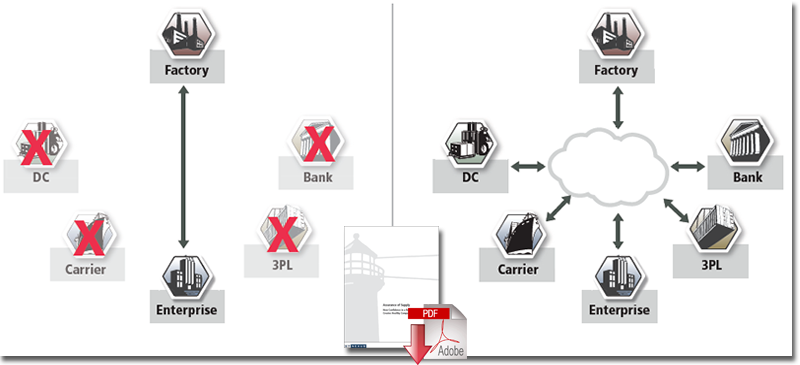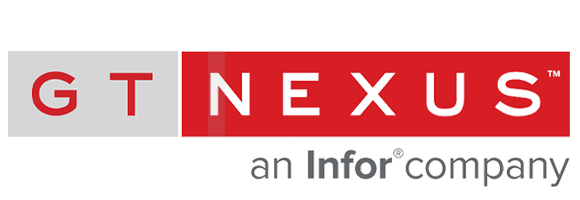7 Ways to Strengthen Assurance of Supply With Cloud Technology

Developing a strong assurance of supply program can give companies the competitive edge they need by gaining visibility into inventory starting at the supplier level, replacing outdated manual processes, and collaborating with suppliers and partners.
A couple of weeks ago, we did a post on 5 supply chain symptoms that can really bring you down.
Now, we find the cure! If you can identify with problems related to visibility and supply flow, you’ll probably benefit from better technology and collaboration with partners.
Here’s how using a cloud-based supply chain platform can improve assurance of supply, and how to use it to gain visibility and control of your supply chain.
1. Collaborate On Order and Supplier Commitments
For a long time, companies have focused on planning as the solution to their supply chain problems. They’ve spent millions on planning and forecasting software only to be thrust into an environment where real demand sharply diverges from the expected. New, networked systems address this problem by including real-time partner data in the information available to supply chain managers.
Supply chain leaders have shifted their focus to execution and tighter integration to provide “rapid-replanning”–that is, to quickly adjust the original plan to meet actual demand. This can be done by uniting teams across procurement, material management, production management, and logistics to identify sources of risk and possible exceptions.
Assurance of Supply: How Confidence in a Reliable Supply Stream Creates Healthy Companies
One of the greatest supply chain challenges that companies face today is to reliably and profitably meet global demand. Outsourced manufacturing, lengthy global supply chains, a large number of suppliers, and volatile demand all create an environment where supply chain decision-makers feel frantic. They worry that their supply base can’t deliver on the promises they’ve made.
Figure 1. Companies get a reliable supply flow when they go from operating in silos to using real-time data from every supply chain partner to allocate inventory and manage disruptions.

Companies that have a strong assurance of supply program have confidence in their ability to fulfill demand. They know when a manufacturing plan is faltering or lead times are expected to grow. They’re able to make changes in the execution stages to account for disruption and volatility. However, in the current global trade environment, there are many companies that lack that confidence. They’re applying old strategies to a new world.
What Used to Work is No Longer Practical
Traditionally, concerns about how to reliably fulfill demand have been left to ERP systems that connect on a one-off basis to systems involved in a company’s supply chain. These fail to paint the entire picture, leaving out crucial data from the many disparate systems involved in a global supply chain. Yesterday’s supply chains were simpler, with most of the data residing within the four walls of the company — and therefore in the company’s ERP software.
Today, a company’s supply chain is dependent on a large number of external partners. Suppliers from various regions ship parts and products globally and they, in turn, source their parts from n-tier suppliers in other regions. Transportation providers, carriers, and 3PLs ship the products across continents to warehouses, stores, or consumers. Financial institutions and third-party agents aid in getting products to final destination and payment. And all of these parties have a one thing in common: a stake in creating a successful supply network.
ERP software can’t turn the external data from multiple partners in a supply chain network into meaningful, real-time information. As a result, enterprises lose control and confidence in their flow of supply. Lead times fluctuate and inventory grows. The spotlight shines on planning, while the real problems lie in the execution.
Better Systems Call for Collaboration
As inventory moves along the supply chain, managers must be able to view points of potential disruption. This starts at the very beginning, with suppliers ensuring materials for production will arrive on time, and ends with the customer paying for the final product. Each point along the supply chain involves different external partners — if all of them have access to a single, updated source of information, they can attain the level of orchestration needed to assure that the flow of supply continues on uninterrupted.
2. Manage Order, Receipt, and WIP Status by Exception
Before actual production, inventory must be monitored closely to identify any potential delays. New systems allow companies to have an exception-based workflow that extends into the supply base, from supply plan to work-in-process production steps.
3. Maximize Supplier Efficiency With Production Visibility
Aligning supply to demand patterns and improving factory compliance can greatly increase supply certainty. A supply chain platform that can enable agility at the supplier factory level will monitor production milestones, compliance, and packing and labeling on a single network, allowing supply chain partners to collaborate easily and make any adjustments necessary to meet demand.
4. Monitor Inventory From End to End
End-to-end visibility is essential in monitoring inventory, especially in the “black hole” that can occur when goods are in the hands of suppliers, contract manufacturers, and transportation partners within the trade network. A cloud-based solution gives companies the complete picture of supply chain inventory, by managing data on available goods, inventory receipts, and in-transit goods. This information is used to dynamically allocate inventory to meet demand, increases the likelihood of getting inventory to customers on time and in full and reduces costs related to operations, expedited freight, and inventory.
5. View Real-Time Transportation and In-Transit Data
In complex supply chains, companies have many disparate transportation systems and agreements with 3PLs and carriers across the globe at various rates. Throughout the transportation booking and execution process, visibility is crucial. A cloud-based control layer manages multiple systems and allows companies to make strategic decisions based on a single source of real-time data.
6. Replace Outdated Invoicing and Settlement Practices
Before networked systems existed that could update all parties involved in invoicing and settlement, a manual three-way matching process was crucial in settling payments for goods. Now, this time-consuming process is eliminated by automatically matching orders, invoices, and receipt of goods in the cloud, in real-time. This lowers costs and cycle times significantly while increasing payables liability internally and payment status externally.
7. Improve Supplier Stability and Relationships
Companies can use their strong credit standings to get their suppliers more favorable financing rates. This process can only be done on a platform where the supplier’s and buyer’s accounts receivable, as well as the bank, can be on the same page. In this case, the buyer issues a purchase order, the supplier delivers the goods and invoices the buyer, and upon approval the supplier is offered an early payment discount enabled by the bank. As days sales outstanding (DSO) is reduced and uncertainty decreased, the supplier becomes confident in its financial standing and ability to fill orders.
Download the following documents to learn more about Assurance of Supply:
- White Paper: Assurance of Supply: How Confidence in a Reliable Supply Stream Creates Healthy Companies
- Aite Group Perspective Piece: Supply Assurance: Eliminating Capital-Related Risk to Prevent Supply Disruption
- EKN Industry Perspective Piece: Solutions & Strategies for Supply Assurance and Collaboration: A Retailer’s Quest for a Unified Buying Cycle
Article Topics
GT Nexus News & Resources
The Current and Future State of Digital Supply Chain Transformation Infor Coleman AI Platform to ‘Rethink Supply Chain’ and Maximize Human Work Potential End-to-End Visibility: Handling the Demands of Retail Mastering Supply Chain Finance ERP Suppliers’ Changing Role New Logistics TMS Platform Sets Sights on SAP Amazon Selects Infor for Global Logistics Business More GT NexusLatest in Technology
U.S. Manufacturing is Growing but Employment Not Keeping Pace The Two Most Important Factors in Last-Mile Delivery Spotlight Startup: Cart.com is Reimagining Logistics Walmart and Swisslog Expand Partnership with New Texas Facility Taking Stock of Today’s Robotics Market and What the Future Holds Biden Gives Samsung $6.4 Billion For Texas Semiconductor Plants Apple Overtaken as World’s Largest Phone Seller More Technology













